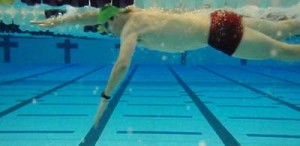Analyzing Jay’s Freestyle
Jay contacted me around a week ago after reading the site, looking for a little swimming help. Happy to get beat up in a public forum, he sent me a couple of videos to look over. So here goes….
The first thing that I have to mention is that these swim videos are done with a wetsuit on. The problem with that is that it can hide certain flaws and habits with all that added buoyancy. Having said that, I can still pick out a few of them even with the suit on. More on that in a bit.
In watching Jay swim, I can tell that he is very comfortable in the water and a good swimmer. I don’t have any racing times, but I’m quite sure he’s not bringing up the rear. Of course this wouldn’t be any fun if I just complemented the stroke and moved on. So let me pick this sucker apart..
First thing I want to touch on is the easy one, and that’s Jay’s pull. Like a lot of people, Jay is dropping his elbow on his pull, and in some of these shots it’s pretty pronounced. As I have mentioned in other areas of this site (here), by leading the pull through the water with your elbow, you minimize the surface area in which you’re pulling yourself through the water. In addition, you use more tricep and less lat by dropping your elbow. Take a look at the still shot of Jay here:
And compare it to the pictures here of a pretty good pull. (There’s also a great one of Grant Hackett on a previous post)
While my pull isn’t perfect, this makes it pretty easy to see the difference, and what needs to be adjusted.
I also noticed that the left arm is entering/extending wider and pulling more air, especially when he breathes. This is easiest to see in the brief head on shot, but you can still see it pretty well on his return trip when the left arm is closest to the camera. The fix? Bilateral breathing. By breathing to both sides you start to move equally between the left and right sides. It also will help prevent injuries as the yards add up as there are fewer ways to favor weak habits.
Another thing I see is that Jay is lifting his head a bit too much to take a breath. While it’s not a big deal in and of itself, a head high in the water usually means a lowering of the hips and forces you to kick harder to keep the proper body position. Try keeping a goggle in the water (or as close as you can) when you rotate to breathe.
Kick. here is one of the areas that a wetsuit is good at hiding. A good kick is used to help facilitate body rotation, body position, and a little bit of propulsion. (more on that here). Ideally you want to minimize how much you kick by making each kick as effective as possible. (For the distances of triathlon, I recommend a 2 beat kick). The less effective the kick, the more kicking you have to do. When I look at Jay’s kick, it looks like the wetsuit is hiding some flaws in his kick. From what I see, the basic fundamentals of the kick are pretty good. Starts at the hip, bend in the knee, whip in the ankle, like kicking a ball. The big problem that I see is the timing. The kick should start the rotation, so when you are rotated to one side, the bottom foot should initiate the rotation in the other direction. In watching Jay, you can see a pronounced kick with his left leg, especially when he breathes. This is simply because Jay is rotating more when he breathes and needs that forceful kick to get him rotating in the other direction. What you don’t see is that same type of timing and force on his right leg. Easiest way to fix this is for Jay to start …..everyone together now…breathing bilaterally. By breathing to the left he will begin to balance out his stroke and force that kick to be more purposeful. Between that and a heathly dose of kick sets, Jay can improve his kick so he rotates better and gets to his bike a bit quicker.
Lastly, You’re arms should extend straight out in front of your body. Jay’s arms are extending in downward (say, 4 o’clock) trajectory as the swim progresses, which shortens the length of his stroke and negatively effects his streamline. Usually this is a flexibility issue, so I would recommend focusing on a good streamline off each wall and a generous amount of stretching when you get out of the pool.
Hopefully there’s a few take home points here and it quickens everyone’s times. Questions? Fire away.
Oh and Jay, thank you for your service to our country. It’s greatly appreciated.



Thanks TJ, appreciate all the feedback. Looks like I have some good things to work on over the winter!